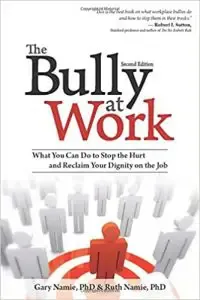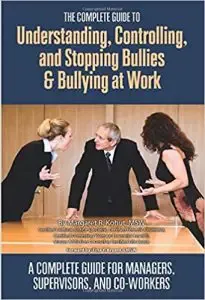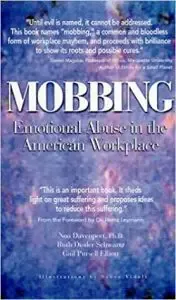Workplace Bullying: 24 Examples & Ideas to Support Adults
 Few, if any, reasonable adults expect to be bullied after school, but that’s exactly what is happening in the workplace.
Few, if any, reasonable adults expect to be bullied after school, but that’s exactly what is happening in the workplace.
According to Dr. Gary Namie (2021), workplace bullying is the only form of abuse in the United States that is not yet taboo. Because it is legal, it remains invisible.
The US Workplace Bullying Survey (Namie, 2017) states that 19% of Americans have experienced abusive conduct at work and another 19% have been witnesses. A whopping 63% are aware that bullying in the workplace occurs.
In this article, we define workplace bullying and share approaches on what can be done about it.
Before you continue, we thought you might like to download our three Work & Career Coaching Exercises for free. These detailed, science-based exercises will help you or your clients identify opportunities for professional growth and create a more meaningful career.
This Article Contains:
- Bullying and Harassment in the Workplace
- 21 Examples of Bullying at Work
- How to Foster a Safe Work Environment
- Anti-Bullying Policies in the Workplace
- Supporting Your Employees: Best Guidelines
- 3 Ideas and Activities for Adults
- Training in Anti-Bullying Interventions
- 3 Best Books on the Topic
- Resources From PositivePsychology.com
- A Take-Home Message
- References
Bullying and Harassment in the Workplace
One thing we know about workplace bullying is that it is eerily similar to school bullying and domestic violence (Kohut, 2008).
Bullying in the workplace is a sublethal and nonphysical form of psychological violence. Namie and Namie (2009) state several criteria must exist for negative behavior to be considered bullying, including a pattern of repeated behavior and health-harming mistreatment of an employee by one or more coworkers that prevents the target from accomplishing work tasks.
Mistreatment can take the form of threatening conduct, including verbal abuse, intimidation, humiliation, or sabotage. Specifically, behaviors might include being ridiculed in front of others, being lied about, continually being left out, and receiving repeated criticism without just cause (Kohut, 2008). These aggressions can leave employees feeling on guard, anxious, intimidated, fearful, powerless, incompetent, and ashamed (Kohut, 2008).
Harassment, on the other hand, violates a target’s civil rights and occurs when the target is a member of a protected status group. In the United States, there are seven protected classes: race, color, religion, sex, national origin, disability, and sexual orientation (Cotterell, 2018).
According to Namie and Namie (2009, p. 299), illegal harassment is status based, whereas “Bullying cuts across boundaries of status group membership.” In other words, “bullying happens when harassment is same-gender or same-race or when the bully enjoys potential legal protection because he or she is a member of a status-protected group” (Namie & Namie, 2009, p. 299).
Workplace torment is complicated, insidious, and ubiquitous.
21 Examples of Bullying at Work

- Profane, threatening, or disrespectful language or any form of verbal abuse.
- Degrading or demeaning remarks that might include insults or name calling.
- Harsh criticism in the presence of other employees.
- Comments that have a negative effect on work performance.
- Behavior that diminishes psychological safety, such as withholding vital job-related information, refusing to answer questions, or refusing to assist when requested.
- Routinely making unfavorable or unreasonable assignments.
- Retaliation against a whistleblower.
- Using position or authority to talk down to or demean another.
- Deliberate exclusion of individuals from meetings or activities they should be attending.
- Shunning, excluding, marginalizing, or using the silent treatment.
- Personal attacks or threatening comments.
- Setting someone up to fail.
- Not providing important assignment-related information.
- Racial, ethnic, sexual, gender, or religious slurs.
- Circulating private correspondence (emails, messages, texts) without permission.
- Rude nonverbal behaviors and/or gestures (e.g., eye rolling, snickering, finger pointing, staring).
- Taking credit for the work of another.
- Gossip mongering or rumor spreading.
- Interrupting.
- Telling personal jokes about a coworker (Bartlett & Bartlett, 2011).
- Forms of manipulation (Bartlett & Bartlett, 2011).
Indicators of being bullied
Namie and Namie (2009) include some signs that the target may be experiencing bullying:
- Feeling ill at the start of the work week.
- Loved one’s request that they stop obsessing about work.
- Favorite activities with friends and family no longer appeal to them.
- Days off are spent exhausted and lifeless.
- Others in the workplace have been told to stop associating with them.
- Constant agitation and anxiety.
- Being accused of incompetence, despite an excellent history.
- A transfer request mysteriously being denied.
How can we protect employees from uncivil workplace behavior?
How to Foster a Safe Work Environment
Although the United States is slowly waking up, it lags behind European countries when it comes to addressing workplace bullying (Davenport, Schwartz, & Elliott, 1999). In this endeavor, Salin et al. (2020) provide ideas for creating a safe work environment.
1. Redesigning the work environment
Reducing role ambiguity and providing opportunities for increased control and latitudinal decision-making can help reduce bullying and manage high-stress jobs. All of these factors have been correlated with workplace bullying (Salin et al., 2020).
2. Institute effective conflict management/resolution systems
Salin et al. (2020) identified interpersonal conflict as one cause of bullying. Developing a system for addressing conflict in relationships and problem-solving in the workplace can lead to a reduction in bullying issues (Salin et al., 2020). Leadership and emotional intelligence training can focus on improving self-awareness and interpersonal skills.
3. Effective leadership
Leadership style has been identified as an important predictor of workplace bullying (Salin et al., 2020).
4. Anti-bullying policies and codes of conduct
Anti-bullying policies should contain a clear statement coming from the top of the organizational chart regarding intolerance for bullying. In addition, the policies should identify what constitutes workplace bullying and the consequences for such behavior (Salin et al., 2020).
5. Raising awareness in the workplace
By raising awareness, organizations demonstrate a workplace culture that won’t tolerate bullying behavior.
Other ideas include addressing the workplace culture and values and developing a positive communication climate.
Kohut (2008) provides ideas for fostering a safe work environment, including:
- Zero-tolerance policies against bullying
- Encourage confidential communication with management
- Annual briefing on signs of workplace bullying
- Upper management reviews all complaints carefully and fairly
- Employee assistance programs
- Conflict resolution training for all employees
- Value all employees equally
Anti-Bullying Policies in the Workplace

The good news is that there are resources available to help organizations determined to affect change.
Using Utah Administrative Code r. 477-16 as a framework, Clark and Ritter (2018) outlined criteria to create a healthy academic workplace environment, which can and should be considered for cross-discipline application. Below are portions of their report.
Examples of desired behaviors (management responsibility)
- Be respectful and model civility.
- Take responsibility and be accountable.
- Celebrate and reward civil encounters and initiatives.
Examples of desired behaviors (employee responsibility)
- Participate and encourage ongoing civility training.
- Practice prevention strategies.
- Recognize and report acts of civility.
Example policy procedures
- Clearly written, comprehensive, easily accessible workplace bullying policies
- Specific step-by-step procedures for addressing bullying
- Wording that includes the reporting responsibility of all who witness bullying behaviors
Kohut (2008) offers an example workplace policy, outlined here.
- Our organization considers workplace bullying to be unacceptable and intolerable under any circumstance. This behavior degrades, harms, intimidates, offends, or humiliates employees. Bullying results in substantial turnover rates, training costs, and loss of productivity in addition to creating a lawsuit risk.
- Our organization adheres to a safe working environment for all employees, free of bullies.
- Our organization has/is creating an internal grievance and investigation system to deal with bullying allegations. Reports of bullying are treated seriously and investigated promptly and impartially.
- Our organization encourages employees (target or witness) to report incidents immediately. Managers will ensure that reportees are not retaliated against in any way. (Be sure to include contact person’s name and information.)
Supporting Your Employees: Best Guidelines
The Workplace Bullying Institute (n.d.) was first developed in 1997 by Drs. Gary and Ruth Namie and is a bountiful resource for targets of bullies, witnesses, managers, and human resources personnel.
Some of the resources for targeted parties include the first steps to take in this situation, books that can help, coaching, and ideas for creating an action plan.
To fight workplace bullying, the institute offers help for writing policies and procedures, ideas for intervention with bullies, and training for all employees.
Other resources that may be of interest on their website include workplace bullying statistics and current legislation. Interestingly, only Utah and California in the United States have legislation for training mandates (Clark & Ritter, 2018).
This website includes a bevy of resources for stressed workers. What if you happen to work for a stressful boss? This website provides ideas on how to work under these conditions and strategies for interacting with your boss.
This practical workplace bullying guide originating from the Government of South Australia provides information and insight and includes definitions, behaviors, and factors that contribute to workplace bullying.
The Professional Institute of the Public Service of Canada has published this website of resources to help combat workplace bullying. In it, you can find information on the impact of workplace bullying, organizational factors, working arrangements, and ideas to address bullying.
3 Ideas and Activities for Adults

Exploring past resilience
Resilience in the Workplace aims to strengthen the abilities to negotiate adverse circumstances and bounce back effectively.
This worksheet provides an opportunity to reflect on a past setback and examine the strategies used to overcome it. A series of questions help guide the client to a deeper understanding of their holistic experience.
Self-Care Checkup
During adversity, self-care is crucial for mental wellbeing. When overwhelmed with issues, we can become complacent and even negligent in areas of self-care, which can decrease wellbeing.
This worksheet helps clients identify which domain – emotional, physical, social, professional, or spiritual – is lacking and in need of support.
A Time You Felt Different
This exercise is for all employees and is intended to build empathy.
Workplace bullies are defined by their lack of empathy, making exercises that address and build empathy crucial. The goal of this exercise is to enhance empathy by practicing empathic listening with a coworker.
The exercise begins by mentally preparing to listen to another person. Listeners are asked to quiet the mind, listen beyond words, and set aside judgments to be fully present for the speaker.
Training in Anti-Bullying Interventions
There are a variety of training topics that can help reduce workplace bullying. Below are just a few.
Workplace Bullying and Violence: Training for Supervisors and Employees
J.J. Keller & Associates offers courses for every size organization. Their Workplace Bullying and Violence: Training for Supervisors and Employees includes an introductory video. They also provide online training.
Cultural intelligence
David Livermore has been writing and speaking about cultural intelligence for years. Cultural intelligence is an individual’s ability to function across national, ethnic, and organizational cultures. Livermore offers cultural intelligence assessments, online learning, workshops, and certification for course completion.
Cultural intelligence includes relational skills, tolerance of uncertainty, adaptability, empathy, and perceptual acuity – all necessary for an inclusive workplace. Culturally intelligent employees can help coalesce people and groups in the workplace.
Workplace training modules
Neil Katz and Associates have been providing a variety of organizational training topics for many years. Dr. Katz is a prolific writer, trainer, professor, and conflict resolution expert.
He and his team have provided training for an array of organizations, institutions, and community partners. They cover topics such as leadership, communication (conflict resolution), teamwork, and emotional intelligence – all skills that can help reduce workplace bullying through better interpersonal interactions and intrapersonal insight.
3 Best Books on the Topic
1. The Bully at Work: What You Can Do to Stop the Hurt and Reclaim Your Dignity on the Job – Gary Namie and Ruth Namie
One of the first books I used to learn about workplace bullying was The Bully at Work, written by Gary and Ruth Namie, a husband and wife team passionate about workplace bullying. For years, they have led the march against workplace bullying.
The Bully at Work extols the impact of workplace bullying on the lives, careers, and families of millions of bullying targets. They are the founders of the Workplace Bullying Institute, established in 1997 to fight bullying.
Their book teaches targets, witnesses, administration, and human resources personnel what workplace bullying is, how to deal with bullies, actions people can take, and how targets can make themselves safe.
Find the book on Amazon.
2. The Complete Guide to Understanding, Controlling, and Stopping Bullies & Bullying at Work – Margaret Kohut
This comprehensive text by Margaret R. Kohut begins with a definition of workplace bullying along with the scope of the issue, then pivots into Profiles of Workplace Bullies.
To explain this toxic behavior in the workplace, this section of the book breaks workplace bullying down by personality disorders such as the narcissist, the antisocial, the paranoid, and the histrionic.
It is both riveting and helpful, as Kohut describes common character traits of each disorder and what to expect from this personality as a boss, coworker, or subordinate.
The toll and types of workplace bullying are included, along with how to survive and what the law says (or doesn’t say) about it. Readers can find experiential exercises and a special section in the appendix on notoriously bad famous bosses. Spoiler alert: Leona Helmsley is included.
Find the book on Amazon.
3. Mobbing: Emotional Abuse in the American Workplace – Noa Davenport, Ruth Schwartz, and Gail Pursell Elliott
This book describes mobbing as emotional assault inflicted on one person by a group of coworkers.
In addition to disrespectful and harmful behavior, mobbing often escalates into abusive and terrorizing behaviors. This book is a must-read.
Find the book on Amazon.
Resources From PositivePsychology.com
Empathy, assertive communication, and team-building skills benefit all employees.
Working on these skills will allow personnel to have insight into their behavior and the behavior of others. The resources below are recommended to build on these skills.
Empathy
This worksheet encourages participants to imagine the perspective of someone with whom they are experiencing difficulty or discomfort and to notice their thoughts and feelings in a quiet and controlled environment.
Looking at any situation through multiple perspectives allows insight and empathy. This exercise could benefit bullies, targets, and witnesses.
Stories and narratives have played a crucial role in society since people began speaking. This exercise helps encourage empathy by asking participants to step into the shoes of another to tell their story. Explaining what the subject of the story thought or felt adds an added empathic layer to the narrative.
Assertive communication
This worksheet outlines individual rights while acknowledging the role that others’ rights and opinions play.
The “right to make mistakes,” which acknowledges the human condition of making mistakes regardless of what others think, is particularly interesting.
This worksheet outlines strategies to help understand and use assertive language. Included in the worksheet is empathy, which is crucial to solving escalating conflict.
Team building
This exercise requires participants to build a degree of vulnerability in order to create trust. Trust in the workplace can help strengthen teams and open lines of communication.
This worksheet creates an opportunity for team members to move beyond their comfort zone and become better acquainted with those outside their immediate circle. The goal of this exercise is to build rapport, strengthen teams, and enhance team performance.
Resilience
If you’re looking for more science-based ways to help others overcome adversity, check out this collection of 17 validated resilience and coping exercises. Use them to help others recover from personal challenges and turn setbacks into opportunities for growth.
A Take-Home Message
Some bullying dynamics have existed in organizations so long that the behaviors have become ingrained as part of the workplace culture. As a result, affected employees are resigned to believing that nothing can be done because the culture is too far gone (Clark & Ritter, 2018).
This is simply not true. Just as we have witnessed deeply troubling sociological issues evolve, workplace bullying, which transcends all demographics, is making strides.
Employees are finding their voice and standing up for their rights. Although the United States lags behind other European countries on this issue (Davenport et al., 1999), creating safe workspaces for all employees is gaining momentum through lawsuits, budding legislation, publicized narratives, and more.
Using the resources provided in this article, each of us can mobilize for safety. Join the movement.
We hope you enjoyed reading this article. Don’t forget to download our three Work & Career Coaching Exercises for free.
- Bartlett, J. E., & Bartlett, M. E. (2011). Workplace bullying: An integrative literature review. Advances in Developing Human Resources, 13(1), 69–84.
- Clark, C. M., & Ritter, K. (2018). Policy to foster civility and support a healthy academic work environment. Journal of Nursing Education, 57(6), 325–331.
- Cotterell, T. (2018). Understanding Title VII: What organizations need to know about employees in protected classes. Forbes.com. Retrieved October 20, 2021, from https://www.forbes.com/sites/forbeshumanresourcescouncil/2018/08/22/understanding-title-vii-what-organizations-need-to-know-about-employees-in-protected-classes/?sh=5b720cf53a32
- Davenport, N., Schwartz, R. D., & Elliott, G. P. (1999). Mobbing: Emotional abuse in the American workplace. Civil Society.
- Kohut, M. R. (2008). The complete guide to understanding, controlling, and stopping bullies and bullying at work. Atlantic.
- Namie, G. (2017). 2017 Workplace Bullying Institute U.S. Workplace Bullying Survey [National statistics on workplace bullying]. Workplacebullyinginstitute.org. Retrieved October 2021, from https://workplacebullying.org/download/2017-wbi/?wpdmdl=2024&refresh=619558c1d89731637177537
- Namie, G. (2021). Workplace bullying: Introduction by Dr. Gary Namie [YouTube video]. Retrieved October 26, 2021, from https://www.youtube.com/watch?v=3w1Xx7skPxs
- Namie, G., & Namie, R. (2009). The bully at work (2nd ed.). Sourcebooks Inc.
- Salin, D., Cowan, R. L., Adewumi, O., Apospori, E., Bochantin, J., D’Cruz, P., … Zedlacher, E. (2020). Prevention of and interventions in workplace bullying: A global study of human resource professionals’ reflections on preferred action. The International Journal of Human Resource Management, 31(20), 2622–2644.
- Workplace Bullying Institute. (n.d.). About us. Retrieved December 6, 2021, from https://workplacebullying.org/about-us/
Let us know your thoughts
Read other articles by their category
- Body & Brain (42)
- Coaching & Application (54)
- Compassion (26)
- Counseling (51)
- Emotional Intelligence (24)
- Gratitude (18)
- Grief & Bereavement (21)
- Happiness & SWB (40)
- Meaning & Values (25)
- Meditation (20)
- Mindfulness (44)
- Motivation & Goals (43)
- Optimism & Mindset (32)
- Positive CBT (25)
- Positive Communication (20)
- Positive Education (45)
- Positive Emotions (30)
- Positive Leadership (14)
- Positive Psychology (32)
- Positive Workplace (33)
- Productivity (16)
- Relationships (42)
- Resilience & Coping (34)
- Self Awareness (20)
- Self Esteem (36)
- Software & Apps (13)
- Strengths & Virtues (30)
- Stress & Burnout Prevention (34)
- Theory & Books (44)
- Therapy Exercises (35)
- Types of Therapy (58)








What our readers think
Am learning everyday. As l read the article. It help me a lot to know when act of bullying is used on me by a coworker or by customer. It also give an insight to when is used against me. Bullying is very terrible l don’t Wish to anyone.
Great article. Thank you for many new insights on how to recognize and defuse bullying in the workplace.
Hi,
I run a group for dually diagnosed adults with developmental disabilities in an Adult Day Program. I plan to use this article in my vocational skill building group. I look so forward to adapting this content, and have them also look at my company’s policy for bullying. Thank you so much!
Hi Amica
Id love more information on tour program. Im based in Australia.